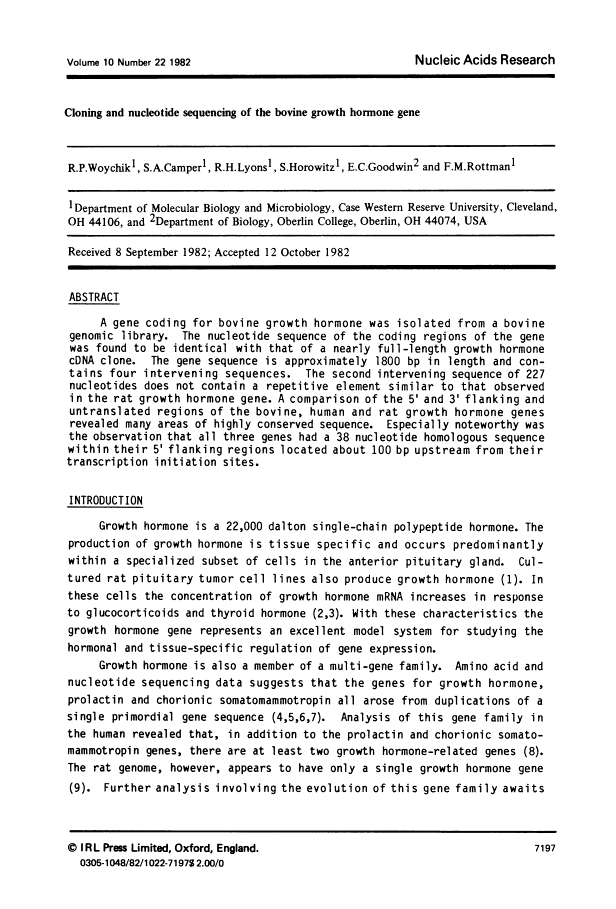Cloning and nucleotide sequencing of the bovine growth hormone gene.
The pbpB gene, which encodes penicillin-binding protein (PBP) 2B of Bacillus subtilis, has been cloned, sequenced, mapped, and mutagenized. The sequence of PBP 2B locations it amongst the class B high-molecular-weight PBPs.
It seems to comprise three useful domains: an N-terminal area homologous to the corresponding area of different class B PBPs, a penicillin-binding area, and a prolonged carboxy extension.
The PBP has a noncleaved sign sequence at its N terminus that presumably serves as its anchor in the cell membrane. Previous research led to the speculation that PBP 2B is required for each vegetative cell division and sporulation septation.
Its sequence, map website, and mutant phenotype assist this speculation. PBP 2B is homologous to PBP 3, the cell division protein encoded by pbpB of Escherichia coli. Moreover, each pbpB genes are situated in the similar relative place inside a cluster of cell division and cell wall genes on their respective chromosomes.
However, instantly adjoining to the B. subtilis pbpB gene is spoVD, which seems to be a sporulation-specific homolog of pbpB. Inactivation of SpoVD blocked synthesis of the cortical peptidoglycan in the spore, whereas carboxy truncation of PBP 2B prompted cells to develop as filaments.
Thus, it seems that a gene duplication has occurred in B. subtilis and that one PBP has developed to serve a standard position in septation throughout each vegetative growth and sporulation, whereas the different PBP serves a specialised position in sporulation.

A gene cluster encoding malonyl-CoA decarboxylase (MatA), malonyl-CoA synthetase (MatB) and a putative dicarboxylate provider protein (MatC) in Rhizobium trifolii–cloning, sequencing, and expression of the enzymes in Escherichia coli.
A gene cluster consisting of three consecutive genes, matABC, was remoted utilizing a probe ready from amino acid sequence data of Rhizobium trifolii malonyl-CoA synthetase, and was subsequently sequenced.
The sequences of matA and matB had been overlapped by 4 base pairs, whereas the intergenic area between matB and matC had 95 base pairs. The upstream area contained DNA sequences that are typical for an Escherichia coli sigma70 promoter, and no different open studying body was discovered inside 400 bp downstream of matC.
The ribosome-binding websites had been discovered 7 to 12 base pairs upstream of every gene. MatA gene encoded a polypeptide of 462 amino acid residues, with deduced molecular mass of 51414 Da.
A glutathione-S-transferase-MatA fusion protein has been purified and MatA was proven to have an intrinsic malonyl-CoA decarboxylase exercise (Km = 0.47 mM; Vmax = 52 micromol x min(-1) x mg(-1)). MatB encoded a polypeptide of 504 amino acid residues with deduced molecular mass of 54612 Da.
MatB was additionally purified from E. coli transformant carrying the gene cluster. The enzyme was primarily indistinguishable from the wild-type malonyl-CoA synthetase of R. trifolii by the standards of polyacrylamide gel electrophoresis and biochemical properties. MatC encoded a 46453-Da protein with a excessive content material of hydrophobic residues.
The deduced amino acid sequences of matC confirmed identification to some extent with anaerobic C4-dicarboxylate provider proteins from E. coli (25%) and Haemophilus influenzae (17%). MatC protein seems to be an integral membrane protein that might perform as a malonate provider.
The formation of acetyl-CoA and malonyl-CoA from malonate was confirmed by thin-layer chromatographic evaluation.
These outcomes strongly recommend that the gene cluster encodes proteins concerned in the malonate-metabolizing system, malonate->>malonyl-CoA->>acetyl-CoA, in R. trifolii and that the metabolic pathway in the malonate-rich clover nodule would possibly play an vital position in symbiosis.
